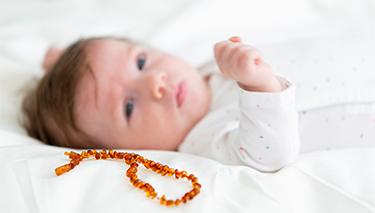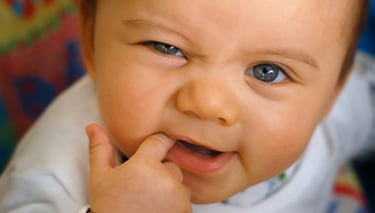Toddlers and young children are just as much at risk of dental decay as an older child or adult. Caring for your toddler’s teeth needs to begin at birth. With good oral hygiene habits early, as your child grows and develops, they are more likely to have healthy teeth for life.
Tips for caring for your toddler’s teeth
Even before your baby’s teeth appear it is recommended that you gently wipe their gums with a moistened soft cloth once a day. During bath-time is a good opportunity.
Once the baby or primary teeth start to appear, anytime from around 9 months of age, it is recommended that parents use a baby’s toothbrush with a small head and soft, rounded bristles. Up to the age of 18 months, teeth should be brushed with plain water, ideally, twice each day and especially well after the last feed in the evening.
There is special children’s toothpastes that have been developed for young children. These special, low dose fluoride toothpastes can be introduced from around the age of 18 months. However always read the individual manufacturer’s directions for age suitability. Use only a smear of toothpaste and teach your child to spit out the toothpaste after brushing.
Store all toothpastes out of your child’s reach. Some small children love the taste of toothpaste and will eat it if given the chance. Doing this can increase the risk of fluorosis on the teeth.
How to teach your child to brush their teeth
Support your toddler if they show interest in brushing their own teeth. But remember, it’s important that you brush their teeth as well until they’re around 8 years of age. Children do not have the manual skills to effectively clean their own teeth until this age. Until then, tooth brushing should be a combined effort by parents and children.
Choose a position where you can easily see your child’s mouth – for example, sit your child on your lap, lie them down on a bed or the couch, or stand behind your child with their head tilted back slightly.
Move the toothbrush gently in small circles to clean the front surfaces of your child’s teeth. To reach inner surfaces, tilt the toothbrush. Avoid side-to-side scrubbing, which can damage teeth and gums. Brush the biting and grinding surfaces of back teeth with a firm back and forth motion. Clean every surface of every tooth. Brush gently around the gum line of each tooth. In total you should aim to brush for about two minutes, although it will take time for your child to allow you to clean for that length of time. You might want to use an app or sing a song which gives a prompt when 2 minutes is up.
Replace toothbrushes every three months, or when bristles appear frayed. Frayed bristles are not effective at removing plaque and may scratch your toddler’s gums.
Did you know?
Plaque-disclosing tablets or drops (available from your dentist or pharmacist) contain food dye that turns plaque pink or red. These can be helpful for parents and toddlers to check if their brushing technique is effective.
Flossing for Children
When your child has two teeth which are touching, start flossing in-between their teeth. Flossing helps remove decay causing bacteria from between the teeth and supports gum health. Slide the floss between the teeth and gently work it up and down, against the surfaces of each tooth. Do not snap the floss down between the teeth as the floss may damage their gums. After flossing, encourage your child to rinse their mouth with water, then brush (or if you prefer, brush then floss) your child’s teeth.
If you find flossing your child’s teeth difficult, ask your dentist to show you how to do it. Floss holders can make flossing easier for some children. You dentist or pharmacist will have a range of floss holders to choose from.
Tips to make oral hygiene more interesting for your kids
If your toddler resists brushing or cannot sit still for two minutes, then try these suggestions:
- Consider using a battery-powered or electric toothbrush, which adds novelty to cleaning their teeth.
- Sing nursery rhymes or play a favourite song while you help your child brush their teeth.
- Set an app on your phone, or a timer as a 2-minute brushing prompt.
- Offer a non-food related reward every time your toddler allows you to brush for two minutes.
- Encourage your child to practise teeth cleaning (under your supervision) to instil good oral hygiene habits from an early age. Use a combination of “show and tell” methods. For example, you could brush your teeth as your child imitates you; then next time, teach your toddler how to brush while you supervise.
Make flossing and brushing as much fun as you can to avoid any negative association or resistance. Talk to your dentist if you need more advice.
Importance of setting a good example
Children tend to imitate their parents’ behaviours. If oral hygiene and dental care are important to you, they are more likely to become important to your child.
Talk to your child about the importance of healthy teeth. A child who understands that teeth need to last a lifetime is more likely to take care of them. Visit your dentist regularly to maintain your own oral health, which will in turn benefit your child.
Is it ok to use the same spoon as your child?
Sharing spoons or tasting your child’s food with the same spoon can transfer decay causing bacteria. Keep a set of spoons only for your child’s use. Wash a dropped dummy under running tap water – don’t clean it in your mouth, as doing this may also transfer decay causing bacteria.
Maintain your own oral health to decrease the likelihood of transferring bacteria which can lead to tooth decay.
More information
For more information visit Australian Dental Association Baby Teeth.
For more information see Baby teething
Reviewed and updated by Jane Barry, Midwife and Child Health Nurse, March 2024.
Last Published* May, 2024
*Please note that the published date may not be the same as the date that the content was created and that information above may have changed since.

















